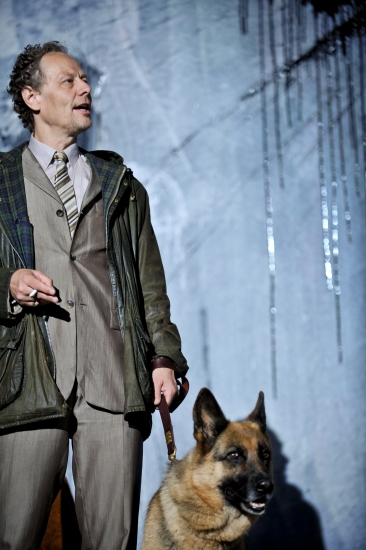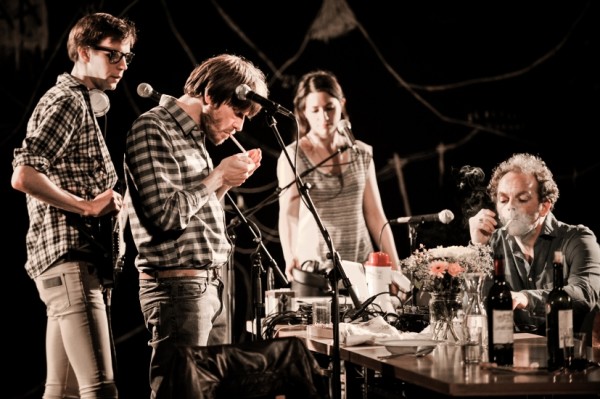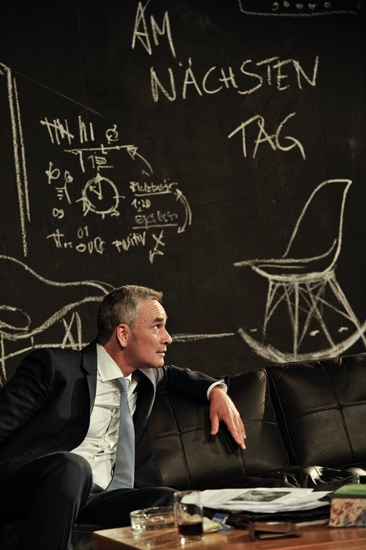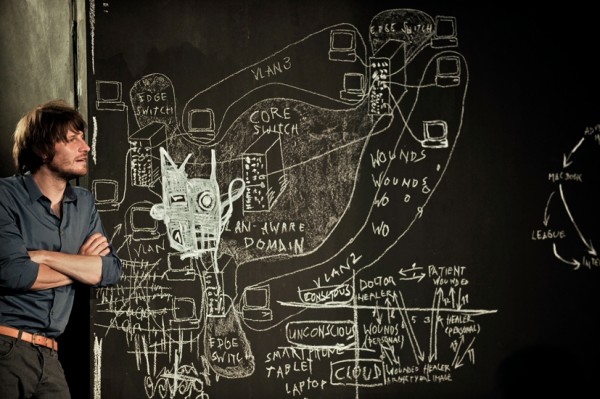Enemy of the people by Henrik Ibsen with Schaubühne in Napoli
Enemy of the people in Napoli
Enemy of the people by Henrik Ibsen with Schaubühne at Napoli Teatro Festival

Enemy of thePeople by Henrik Ibsen with Schaubühne Berlin at Napoli Teatro Festival, Foto: Schaubühne, Berlin.
Review by Bruno Tredicine, Fotos: Schaubühne, Berlin
NAPOLI/ITALY: Berlin’s celebrated Schaubühne is guesting Napoli Teatro Festival with Henrik Ibsen’s Volksfeind (Norwegian: En folkefiende, Enemy of the people)
. Directed by Thomas Ostermeier.
Napoli Teatro Festival is the international theatre festival which takes place every summer in Naples
. Kulturkompasset has followed in the past years the best performances of it: we remember Bob Wilson’s Case Makropoulos or Cechov’s Three sisters coming directly from Moscow Mossovet Theatre with the direction by Andrey Konchalovski.
This year the program is a bit disappointing with less companies from abroad and an increasing number of Italian productions, something that the local audience can see also in the ‘normal’ seasons. A mirror of times or just box-office necessity? The last seems not to be the right answer because in the past also productions in other languages were rewarded by a great interest from the public.
Anyway one of the most awaited performances in 2015 arrived directly from Berlin’s celebrated Schaubühne with Henrik Ibsen’s Volksfeind (Norwegian: En folkefinde, Enemy of the people), a play that the company has brought on tour already in Europe and also in Australia or China.

Enemy of thePeople by Henrik Ibsen with Schaubühne Berlin at Napoli Teatro Festival, Foto: Schaubühne, Berlin.
The drama’s plot is still current: a doctor of a small thermal town discovers that the water coming to the spa is highly polluted, and that guests who had already showed illnesses, were actually infected there. At first relatives and friends feel outraged about the discover claiming a sudden report to authorities and to the press; then also the persons who should be the nearest to the protagonist (like his brother for instance, who is also a city counseillor) take distance from him fearing an economical breakdown for the city and dramatic consequencies on the town’s prosperity. Let alone, the doctor will hold a violent speech against the town expressing under the rage almost antidemocratic feelings and is violently assaulted by the citizens.

Enemy of thePeople by Henrik Ibsen with Schaubühne Berlin at Napoli Teatro Festival, Foto: Schaubühne, Berlin.
This is one of the less represented Ibsen’s play, written in 1882 and it had also a Hollywood version in the late sixties, starring Steve McQueen.
The dramaturgy by Florian Borchmeyer updates the drama to the present time, and stage director Thomas Ostermeier, has changed the characters: Dr. Stockman here is not a mature man with three sons, two of them fairly grown-up, but is young, full of energy and idealistic. He and his wife have only a newborn baby.

Enemy of thePeople by Henrik Ibsen with Schaubühne Berlin at Napoli Teatro Festival, Foto: Schaubühne, Berlin.
Let’s say that the actualization is not a good idea: everyone asks to himself why all this fuss about having the research published on newspaper when in Internet era it would be enough to bring them on Facebook or Twitter. But so it is, and Ostermeier gives to the play a fast pace, very dynamic, almost ‘rock’, in line with the hipster look of the protagonists (costumes are designed by Nina Wetzel in full Urban Outfitters style) and the fact that here and there, mainly in the separations between two scenes, they sing as a rock band songs like David Bowie’s Changes, something that don’t integrate very well in the play.
The modern scenography by Jan Pappelbaum shows walls like a blackboard with furniture drawed on them by Katharina Ziemke, then they are covered with white painting by the same members of the cast before the second scene when Stockmann’s apartment becomes the seat of the local newspaper.
The play is given in a long single act without intermission. Nevertheless the acting in itself is quite naturalistic for three quarters of it, any outrageous acting-style like one would expect from a german modern company.
In the last part there is a turning point: the doctor’s speech is changed with a (too) long excerpt from a French anarchist manifesto about how selfish is individualism against the common good. At a certain point lights are turned on and some of the actors come down in the stall asking to the audience if they agree with Dr. Stockmann’s arguments.

Enemy of thePeople by Henrik Ibsen with Schaubühne Berlin at Napoli Teatro Festival, Foto: Schaubühne, Berlin.
At first (as always in such cases) everyone is shy and embarrassed, then thanks to two german interpreters people start to interact. Not everybody from the audience said something memorable: as it was easy to imagine the discussion comes on local themes and specially in the city of Naples, if a play is about pollution of water or food the memory comes easily to similar scandals discovered in recent years
approach to its assessment and treatment. This consensus buy viagra relationship problems can impair erectile functioning by.
. So this part of the performance has not enriched the meaning of Ibsen’s statements. What people say looks more as living-room discussions in front of TV when we protest against politics, and the result is only that the tension of the play is broken for having a poor discussion about local problems sort of the polemics that takes place in front of the TV watching the news.
The very final is much more altered: in the original the townspeople turn against Stockmann violently, here the audience is brought to agree with him and the attack is left to the other characters with balloons full of painting. Then the play finishes back in the doctor’s home with him and his wife staring at the spa’s stocks that her father gave them. They reflect if they should take advantage of this occasion and renounce to their ideal or not, when all in a sudden lights are turned off.
The artists on scene were all definitely ‘into’ the spirit of the play their acting excellent starting from Christoph Gawenda as the motivated Dr. Stockmann and Eva Meckbach equally concerned as his wife. Ingo Hülsmann is very effective as the icy cold councillor and Thomas Bading is the mysterious father in law Morten Kiil, owner of the factory that is poisoning the water always on stage with his wolf-dog.
David Ruland makes of his Aslaksen the prototype of the opportunist publisher, as good as Andreas Schröder as Hovstadt. Moritz Gottwald’s Billing who has also a short rap intermission in DJ’s style. (in Ibsen’s original, the mayor) and David Ruland’s Aslaksen, the newspaper publisher and head of the local property owners’ association, are perfectly casted.
At the end the audience of the first performance was conquered and admired with long ovations for the actors and Ostermeyer.
Distribution:
DIRECTED BY: THOMAS OSTERMEIER
DRAMATURGY: FLORIAN BORCHMEYER
Dr. Stockmann: CHRISTOPH GAWENDA
Morten Kil: THOMAS BADING
Billing: MORITZ GOTTWALD
Counselor: INGO HÜLSMANN
Mrs
. Stockmann: EVA MECKBACH
Aslaksen: DAVID RULAND
Hovstad: ANDREAS SCHRÖDERS
SET DESIGN: JAN PAPPELBAUM
COSTUME DESIGN: NINA WETZEL
MUSIC: MALTE BECKENBACH, DANIEL FREITAG
LIGHT DESIGN: ERICH SCHNEIDER
WALL PAINTINGS: KATHARINA ZIEMKE
PRODUCTION: SCHAUBÜHNE BERLIN
